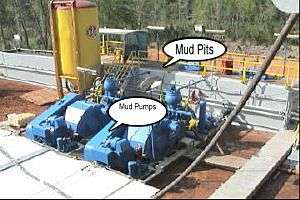Mud pump

A mud pump is a reciprocating piston/plunger device designed to circulate drilling fluid under high pressure (up to 7,500 psi (52,000 kPa) ) down the drill string and back up the annulus.
Mud pump is a large reciprocating pump used to circulate the mud (drilling fluid) on a drilling rig. It is an important part of the oil well drilling equipment.[1]
Classification
According to the acting type
Mud Pumps can be divided into single-acting pump and double-acting pump according to the completion times of the suction and drainage acting in one cycle of the piston's reciprocating motion.
According to the quantity of liners (piston/plunger)
Mud Pumps come in a variety of sizes and configurations but for the typical petroleum drilling rig, the triplex (three piston/plunger) Mud Pump is the pump of choice. Duplex Mud Pumps (two piston/plungers) have generally been replaced by the triplex pump, but are still common in developing countries. Two later developments are the hex pump with six vertical pistons/plungers, and various quintuplex's with five horizontal piston/plungers. The advantages that these new pumps have over convention triplex pumps is a lower mud noise which assists with better Measurement while drilling (MWD) and Logging while drilling (LWD) decoding.
Composition
The "normal" Mud Pump consists of two main sub-assemblies, the fluid end and the power end.
Fluid End
The fluid end produces the pumping process with valves, pistons, and liners. Because these components are high-wear items, modern pumps are designed to allow quick replacement of these parts..
To reduce severe vibration caused by the pumping process, these pumps incorporate both a suction and discharge pulsation dampener. These are connected to the inlet and outlet of the fluid end.
Power End
The power end converts the rotation of the drive shaft to the reciprocating motion of the pistons. In most cases a crosshead crank gear is used for this.
Mud Pump Parts
A Mud Pump is composed of many parts including Mud Pump liner, Mud Pump piston, modules, hydraulic seat pullers, and other parts. Parts of Mud Pump: 1. housing itself, 2. liner with packing, 3. cover plus packing, 4. piston and piston rod, 5. suction valve and discharge valve with their seats, 6. stuffing box (only in double-acting pumps), 7. gland (only in double-acting pumps), 8. pulsation dampener.
Performance Parameters
There are two main parameters to measure the performance of a Mud Pump: Displacement and Pressure.
Displacement
Displacement is calculated as discharged liters per minute, it is related with the drilling hole diameter and the return speed of drilling fluid from the bottom of the hole, i.e. the larger the diameter of drilling hole, the larger the desired displacement. The return speed of drilling fluid should reach the requirement that can wash away the debris and rock powder cut by the drill from the bottom of the hole in a timely manner, and reliably carry them to the earth surface. When drilling geological core, the speed is generally in range of 0.4 to 1.0 m^3/min.
Pressure
The pressure size of the pump depends on the depth of the drilling hole, the resistance of flushing fluid (drilling fluid) through the channel, as well as the nature of the conveying drilling fluid. The deeper the drilling hole and the greater the pipeline resistance, the higher the pressure needed.
With the changes of drilling hole diameter and depth, it requires that the displacement of the pump can be adjusted accordingly. In the Mud Pump mechanism, the gearbox or hydraulic motor is equipped to adjust its speed and displacement. In order to accurately grasp the changes in pressure and displacement, a flow meter and pressure gauge are installed in the Mud Pump.
Characteristics
- The structure is simple and easy for disassembly and maintenance,
- smooth operation, small vibration and low noise,
- it can deliver high concentration and high viscosity (less than 10000 PaS) suspended slurry,
- the drilling fluid flow is stable, no overcurrent, pulsation and stirred, shear slurry phenomena,
- the discharge pressure has nothing to do with the speed, low flow can also maintain a high discharge pressure,
- displacement is proportional to the speed, by shifting mechanism or motor, one can adjust the displacement,
- it has high self-absorption ability, and can suck liquid directly without bottom valve.
Maintenance
The construction department should have a special maintenance worker that is responsible for the maintenance and repair of the machine. Mud Pumps and other mechanical equipment should be inspected and maintained on a scheduled and timely basis to find and address problems ahead of time, in order to avoid unscheduled shutdown. The worker should attend to the size of the sediment particles; when finding large particles, the Mud Pump wearing parts should frequently be checked for repairing needs or replacement. The wearing parts for Mud Pumps include pump casing, bearings, impeller, piston, liner, etc. Advanced antiwear measures should be adopted to increase the service life of the wearing parts, which can reduce the investment cost of the project, and improve production efficiency. At the same time, wearing parts and other Mud Pump parts should be repaired rather than replaced when possible.
References
- ↑ What is Mud Pump, KEHUABEST.COM.
External links
| Wikimedia Commons has media related to Pumps. |